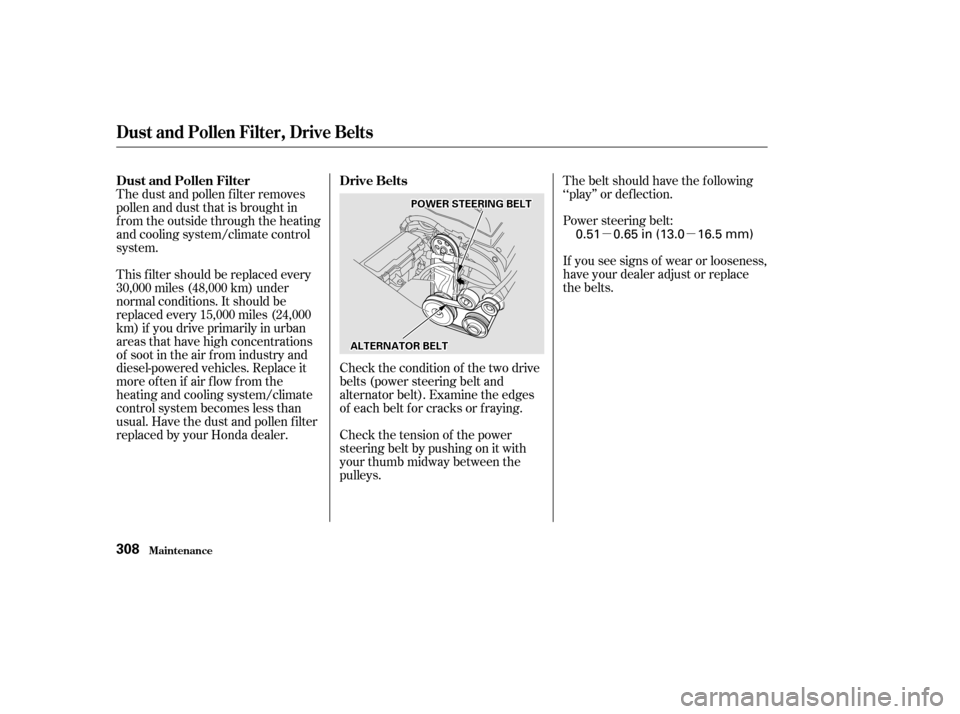Page 152 of 399
You can manually select various
f unctions of the Climate Control
system when it is in FULL AUTO.
All other f eatures remain auto-
matically controlled. Some of these
f unctions appear in the Navigation
System display. Press the A/C
button next to the display to show
these functions.
Pressing ‘‘ON’’ or ‘‘OFF’’ in the
display turns the air conditioning on
andoff.YouwillseeA/CONorA/C
OFF activated in the display.
When you turn the A/C of f , the
system cannot regulate the inside
temperature if you set it below the
outside temperature. With the A/C
on, use the temperature buttons to
adjust the temperature of the air
flow to a comfortable setting.
CONT INUED
Climat e Cont rol Syst em
Comf ort and Convenience Feat ures
Semi-automatic Operation
A ir Condit ioning (A /C) But t ons
149
A AI
IRR C
COON NDDI
ITT I
IOON NIINNG G (
(A
A /
/C
C) )B
BU UT TT
TO
ON NSS
T
T
E
EM
M P
PE
ER
RA A T
TU
UR REE B
BUUT TT
TO
ON NSS
R
RE EC
CI IRRC CUUL LAA T
TI
IOON N B
BUUT TT
TO
ON N
Page 156 of 399
Theclimatecontrolsystemhastwo
sensors. A sunlight sensor is located
in the top of the dashboard and a
temperature sensor is next to the
steering column. Do not cover the
sensors or spill any liquid on them. Sunlight Sensor/T emperature
Sensor
Climat e Cont rol Syst em
Comf ort and Convenience Feat ures153
T TE
EM
M P
PE
ER
RA A T
TU
UR REE S
SEEN
NS SOOR R
S
SU UN NLLIIGGH HT
T S
SEEN
NS SOOR R
Page 157 of 399
Your vehicle has two controls f or the
rear A/C unit. The rear A/C control
dial is located on the climate control
panel, and the rear A/C passenger
control panel is on the ceiling behind
the driver’s seat.
You can adjust the heating, cooling,
and air f low of the rear A/C unit with
these control dials. The rear
passengers can also adjust the
direction and the amount of air f low
with the rear ceiling vents. Rear A/C Unit
Comf ort and Convenience Feat ures
Climat e Cont rol Syst em
154
R REEA
A R
R A
A/
/C
C P
PA
A S
SSSEEN
NG GEER
R
C
CO ON NTTR
RO OL L P
PA
A N
NE EL
L
R
RE
EA
A R
R C
CEEI
ILLI INNG G V
VE
EN
NT T R
RE
EA
A R
R A
A/
/C
C
C
CO ON NTTR
RO OL L D
DI
IAA L
L
Page 311 of 399

�µ�µ
Check the condition of the two drive
belts (power steering belt and
alternator belt). Examine the edges
of each belt f or cracks or f raying. If you see signs of wear or looseness,
have your dealer adjust or replace
the belts. Power steering belt: Thebeltshouldhavethefollowing
‘‘play’’ or def lection.
Check the tension of the power
steering belt by pushing on it with
your thumb midway between the
pulleys.
The dust and pollen f ilter removes
pollen and dust that is brought in
f rom the outside through the heating
and cooling system/climate control
system.
This f ilter should be replaced every
30,000 miles (48,000 km) under
normal conditions. It should be
replaced every 15,000 miles (24,000
km) if you drive primarily in urban
areas that have high concentrations
of soot in the air f rom industry and
diesel-powered vehicles. Replace it
more of ten if air f low f rom the
heating and cooling system/climate
control system becomes less than
usual. Have the dust and pollen f ilter
replaced by your Honda dealer.
Drive Belts
Dust and Pollen Filter
Maint enance
Dust and Pollen Filter, Drive Belts
308
P P O
OW WE ER
R S
STTE
EE
ER
RI INNG G B
BEEL
LTT
A
A L
LTT E
ER
RN NA AT
TO
OR R B
BEEL
LTT
0.51 0.65 in (13.0 16.5 mm)
Page 338 of 399

Two f actors normally contribute to
causing corrosion in your vehicle:Moisture trapped in body cavities.
Dirtandroadsaltthatcollectsin
hollows on the underside of the
vehicle stays damp, promoting
corrosion in that area.
Removal of paint and protective
coatings f rom the exterior and
underside of the vehicle. Repair chips and scratches in the
paint as soon as you discover them.
Many corrosion-preventive measures
are built into your Honda. You can
help keep your vehicle f rom
corroding by perf orming some
simple periodic maintenance:
Inspect and clean out the drain
holes in the bottom of the doors
and body.
Check the f loor coverings f or
dampness. Carpeting and f loor
mats may remain damp f or a long
time, especially in winter. This
dampness can eventually cause
the f loor panels to corrode. Use a high-pressure spray to clean
the underside of your vehicle. This
is especially important in areas
that use road salt in winter. It is
also a good idea in humid climates
and areas subject to salt air. Be
caref ul of the ABS wheel sensors
and wiring at each wheel.
Have the corrosion-preventive
coatings on the underside of your
vehicle inspected and repaired
periodically.
1.
2.
Corrosion Prot ect ion
Appearance Care335
Page 352 of 399

To jump start your vehicle, f ollow
these directions closely:
If your vehicle’s battery has run
down,youmaybeabletostartthe
engine by using a booster battery.
Although this seems like a simple
procedure, you should take several
precautions.
Put the transmission in Neutral or
Park, and set the parking brake. Open the hood and check the
physical condition of the battery
(see page ). In very cold
weather, check the condition of
the electrolyte. If it seems slushy
or like ice, do not try jump starting
until it thaws.
You cannot start a Honda by pushing
or pulling it. Turn of f all the electrical acces-
sories: heater, A/C, climate
control, stereo system, lights, etc.
Your vehicle has the Immobilizer
System. You should use a
properly-coded master or valet key
to start the engine (see page ).
A key that is not properly coded
will cause the immobilizer system
indicator in the dash panel to blink
rapidly.
Do you have f uel? Turn the
ignition switch to ON (II) for a
minute and watch the f uel gauge.
The low f uel level warning light
may not be working, so you were
not reminded to f ill the tank.
There may be an electrical
problem, such as no power to the
f uel pump. Check all the f uses
(see page ).
If youfindnothingwrong,youwill
need a qualif ied technician to f ind
the problem. See on page . 1.
2.
365 303
80
360
CONT INUED
Jump Starting
Emergency
Towing
If Your Engine Won’t Start, Jump Starting
T aking Care of t he Unexpect ed349
A battery can explode if you do
not follow the correct procedure,
seriously injuring anyone
nearby.
Keep all sparks, open flames,
and smoking materials away
from the battery. If a battery sits in extreme cold, the
electrolyte inside can f reeze.
Attempting to jump start with a f rozen
battery can cause it to rupture.
Page 355 of 399

Saf ely pull to the side of the road.
Put the transmission in Neutral or
Park and set the parking brake.
Turn of f the heating and cooling/
climate control system and all
otheraccessories.Turnonthe
hazard warning indicators.
If you see steam and/or spray
coming f rom under the hood, turn
of f the engine.If you do not see steam or spray,
leave the engine running and
watch the temperature gauge. If
the high heat is due to overloading
(climbing a long, steep hill on a
hot day with the A/C running, f or
example), the engine should start
to cool down almost immediately.
If it does, wait until the tempera-
ture gauge comes down to the mid-
point then continue driving.
If the temperature gauge stays at
the red mark, turn of f the engine.
Wait until you see no more signs
of steam or spray, then open the
hood.Look f or any obvious coolant leaks,
such as a split radiator hose.
Everything is still extremely hot,
so use caution. If you f ind a leak, it
must be repaired bef ore you
continue driving (see
on page ).
If you don’t f ind an obvious leak,
check the coolant level in the
radiator reserve tank (see page ). If the level is below the
MIN mark, add coolant to halfway
between the MIN and MAX marks.
1.
2.
3.
7. 6.
5. 4. 237365
If Your Engine Overheats
T aking Care of t he Unexpect ed
Emergency
Towing
352
Page 356 of 399

If there was no coolant in the
reserve tank, you may also have to
add coolant to the radiator. Let the
engine cool down until the pointer
reaches the middle of the tempera-
ture gauge, or lower, bef ore check-
ing the radiator.Using gloves or a large heavy
cloth, turn the radiator cap
counterclockwise, without pushing
down, to the f irst stop. This
releases any remaining pressure in
the cooling system. After the
pressure releases, push down on
the cap and turn it until it comes
off.
Start the engine and set the
temperature control dial to
maximum (climate control to
FULL AUTO at 90°F/32°C). Add
coolant to the radiator up to the
base of the f iller neck. If you do
not have the proper coolant
mixture available, you can add
plain water. Remember to have
the cooling system drained and
ref illed with the proper mixture as
soon as you can.Put the radiator cap back on
tightly. Run the engine and watch
the temperature gauge. If it goes
back to the red mark, the engine
needs repair. (See
on page .)
If the temperature stays normal,
check the coolant level in the
radiator reserve tank. If it has
gone down, add coolant to the
MAX mark. Put the cap back on
tightly.
8.
9.
10. 12. 11.
365Emergency
Towing
If Your Engine Overheats
T aking Care of t he Unexpect ed353
Removing the radiator cap
while the engine is hot can
cause the coolant to spray out,
seriously scalding you.
Always let the engine and
radiator cool down before
removing the radiator cap.